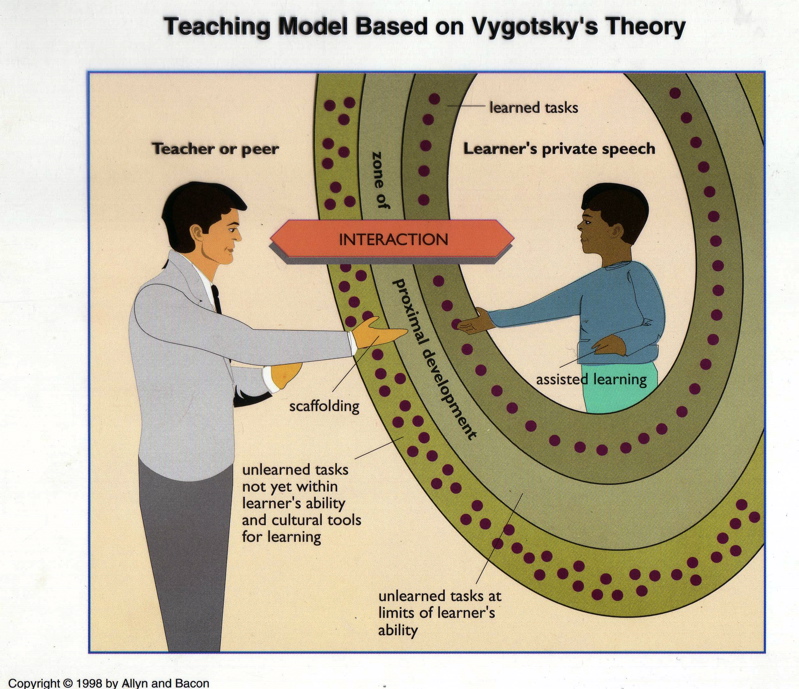Lesson 3 - Vygotky's Sociocultural Development
You may also check your understanding of the material on the Ablongman web site. Click on the Publisher Help Site button.
![]()
Presentation of Theoretical Construct
![]()
Lecture Information:
Zone of Proximal Development (ZPD)
This page will deal with Vygotsky's Model for learning that is
consistent with his socio-cultural theory. The diagram below
demonstrates the complexity and reciprocal nature of the Zone of
Proximal Development. In Vygotsky's view, there are three
different conceptual areas of knowledge, skills and abilities.
Development is dependent on the social interaction with a more
knowledgeable peer or authority figure. Please refer to the
diagram below.

Inner-Layer:
In the above diagram, this is the layer that is closest to the learner.
It represents all of the knowledge, skills and abilities that the
learner has complete control over. That is to say that these are
items that the learner needs virtually no social interaction in
performing. It is a matter of conscious choice as to whether or
not to do them. For example, since you are reading this, you
must also have complete control of the English alphabet. You can
create as well as recognize familiar groupings of the letters into words
that have meanings and structures. You can choose to continue
reading or not. It is entirely void of any real social
interaction.
Outer-Layer:
In the above diagram, this is the layer that is farthest from the
learner. It represents all of the knowledge, skills and abilities
that the learner would have so much difficulty acquiring that they would
soon become frustrated and give up. I think Vygotsky would
emphasize that this is where the role of culture and language ability
would play a profound role as well. These items that would likely
frustrate, are also very likely to be the items that are not valued by
their culture or are not a part of their cultural experience, or are not
part of their available resources. The language may also be a
barrier here as well. The learner may simply not have the
vocabulary to understand the new concepts. For example, I might be
the world's worst auto mechanic. My family didn't value such
activities. No one sat around the dinner table discussing the
merits of any carburetors. Consequently, I view mechanics on a par
with medical doctors; they keep your car healthy.
Middle-Layer:
In the diagram, this is the layer sandwiched between the inner & outer
layers. It is this layer that Vygotsky views as the Zone of
Proximal Development (ZPD). The items at this level are outside of
the learner's control and can be learned only through social
interaction/instruction from a more knowledgeable peer/authority figure.
This speaks to the concept that people are dependent on one another for
expansion of their knowledge base. The example that I most
commonly use is how you learned to play video games. Most often
you were at a friend's house who had a Playstation, Nintendo, or X-Box,
who then demonstrated the intricacies and strategies of each of the
games and controller.
The 90/10 Rule:
This concept might be best understood as a common folk wisdom from
practicing teachers. Relative to their peers, some have a large
potential for learning, and would therefore be thought of by Vygotsky as
having a large ZPD. Others have a relatively low potential for
learning and would therefore be classified as having a small ZPD.
Those students with a large ZPD (the gifted & talented) therefore need
very little social interaction/instruction in order for them to learn
efficiently and thoroughly. However, students with a relatively
small ZPD need a great deal of social interaction/instruction in order
for them to learn adequately. This goes a long way to explain the
perception of many practicing teachers, that it at least feels that you
spend 90% of your time as a teacher with only 10% of the students.






